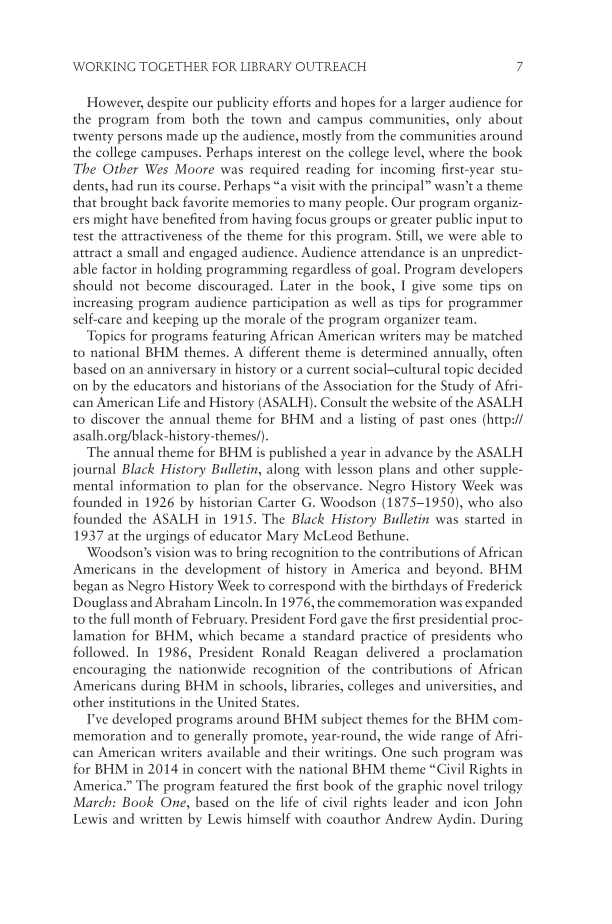Working Together for Library Outreach 7 However, despite our publicity efforts and hopes for a larger audience for the program from both the town and campus communities, only about twenty persons made up the audience, mostly from the communities around the college campuses. Perhaps interest on the college level, where the book The Other Wes Moore was required reading for incoming first-year stu- dents, had run its course. Perhaps “a visit with the principal” wasn’t a theme that brought back favorite memories to many people. Our program organiz- ers might have benefited from having focus groups or greater public input to test the attractiveness of the theme for this program. Still, we were able to attract a small and engaged audience. Audience attendance is an unpredict- able factor in holding programming regardless of goal. Program developers should not become discouraged. Later in the book, I give some tips on increasing program audience participation as well as tips for programmer self-care and keeping up the morale of the program organizer team. Topics for programs featuring African American writers may be matched to national BHM themes. A different theme is determined annually, often based on an anniversary in history or a current social–cultural topic decided on by the educators and historians of the Association for the Study of Afri- can American Life and History (ASALH). Consult the website of the ASALH to discover the annual theme for BHM and a listing of past ones (http:// asalh.org/black-history-themes/). The annual theme for BHM is published a year in advance by the ASALH journal Black History Bulletin, along with lesson plans and other supple- mental information to plan for the observance. Negro History Week was founded in 1926 by historian Carter G. Woodson (1875–1950), who also founded the ASALH in 1915. The Black History Bulletin was started in 1937 at the urgings of educator Mary McLeod Bethune. Woodson’s vision was to bring recognition to the contributions of African Americans in the development of history in America and beyond. BHM began as Negro History Week to correspond with the birthdays of Frederick Douglass and Abraham Lincoln. In 1976, the commemoration was expanded to the full month of February. President Ford gave the first presidential proc- lamation for BHM, which became a standard practice of presidents who followed. In 1986, President Ronald Reagan delivered a proclamation encouraging the nationwide recognition of the contributions of African Americans during BHM in schools, libraries, colleges and universities, and other institutions in the United States. I’ve developed programs around BHM subject themes for the BHM com- memoration and to generally promote, year-round, the wide range of Afri- can American writers available and their writings. One such program was for BHM in 2014 in concert with the national BHM theme “Civil Rights in America.” The program featured the first book of the graphic novel trilogy March: Book One, based on the life of civil rights leader and icon John Lewis and written by Lewis himself with coauthor Andrew Aydin. During
Document Details My Account Print multiple pages
Print
You have printed 0 times in the last 24 hours.
Your print count will reset on at .
You may print 0 more time(s) before then.
You may print a maximum of 0 pages at a time.





































































































































































